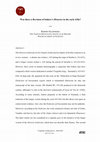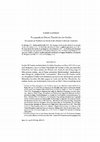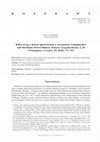Papers by Robert Kasperski
Zegary, cytra i złoto, czyli o symbolice darów w dyplomacji Teodoryka Wielkiego [w:] Rzecz niepospolita. Przedmiot jako symbol statusu, władzy i funkcji w średniowieczu i w epoce nowożytnej, ed. M. Saczyńska-Vercamer, E. Wółkiewicz, Warszawa 2022, s. 13-24
in: Origin Legends in Early Medieval Western Europe Series: Reading Medieval Sources, Volume: 6 Volume Editors: Lindy Brady and Patrick Wadden, pp. 135-155, 2022

2020, Visigothic Symposium 4 (2020-2021): Manuscripts and Editions, 2020
The Historia Gothorum (or De Origine Gothorum) by Isidore of Seville is known to us in two versio... more The Historia Gothorum (or De Origine Gothorum) by Isidore of Seville is known to us in two versions-a shorter one written c. 619 during the reign of Sisebut (r. 612-621), and a longer version written c. 624 during the period of Swintila (r. 621-631/633). However, there exists in modern historiography a conjecture that Isidore may have composed a third version dedicated to another Visigothic king-Sisenand (r. 631/633-636). In large part, the argument for this rests on the "Dedication to King Sisenand" (Dedicatio ad Sisenandum regem) which is transmitted effectively by only one manuscript of the later version, MS Madrid BU 134 (M) produced in the thirteenth century, although it is also in the derivative manuscripts of Lucas de Tuy [d. 1249]). According to some scholars, Isidore prepared, at the behest of Sisenand, a final redaction of the longer version during the years 633-636, but this thesis rests upon on controversial evidence. Inter alia, the Dedicatio ad Sisenandum may not be authentic. Moreover, according to the Dedicatio, the work contained a history not only of Goths, Vandals, and Sueves, but also of the Alans (Alanos) and even Spaniards (Hispanos). The latter clearly are not considered as a separate gens in the narrative of the longer version of the Historia Gothorum, which does not describe their history. The second

Kobiety z długimi brodami" kontra "mężczyźni z kobiecymi włosami", czyli o Origo gentis Langobard... more Kobiety z długimi brodami" kontra "mężczyźni z kobiecymi włosami", czyli o Origo gentis Langobardorum uwag kilka "Barba igitur virilitatis indicium est" św. Hieronim Wprowadzenie Edictum Rothari, czyli edykt longobardzkiego króla Rothariego (panował 636-652) zawiera krótkie dzieło, które szybko otrzymało tytuł Origo gentis Langobardorum (dalej: OGL). Powstało ono dużo później niż sam edykt, bo dopiero około 668/671 r., najprawdopodobniej za panowania króla Longobardów, Grimoalda I (panował 662-671). OGL zawiera opowieść o tym, jak Longobardowie zwyciężyli Wandalów. Jej źródłem, jak się od dawna twierdzi, był plemienny mit Longobardów, będący z pewnością opowieścią o wiele bogatszą w szczegóły niż znana nam fabuła 1 . Dużo uboższą -od znanej z OGL -wersję opowieści przekazuje kronika tzw. Fredegara (powstała około 660 r.), według której Longobardowie nie pokonali Wandalów, lecz 1 Origo gentis Langobardorum, c. 1, wyd. G. Waitz (MGH SS rer. Lang.), Hannover 1878, s. 2-3. Zob. K. Hauck, Lebensnormen und Kultmythen in germanischen Stammes-und Herrschergenealogien, "Saeculum" 6, 1955, s. 186-223; S. Gasparri, La cultura tradizionale die Longobardi: Struttura tribale e Resistenze pagane, Spoleto 1983, s. 37-40; H. Wolfram, Origo et religio: Ethnic Traditions and Literature in Early Medieval Texts, "Early Medieval Europe" 3, 1994, s. 19-38, zwł. 21-23; W. Pohl, Gender and Ethnicity in the Early Middle Ages, w: Gender in the Early Medieval World: East and West, 300-900, red. L. Brubaker, J. M. H. Smith, Cambridge 2004, s. 23-43; A. Plassmann, Origo gentis. Identitäts-und Legitimitätsstiftung in früh-und hochmittelalterlichen Herkunftserzählungen, Berlin 2006, s. 204-215; H. Castritius, Die Vandalen. Etappen einer Spurensuche, Stuttgart 2007, s. 36; M. Coumert, Origines des peuples. Les récits du Haut Moyen Âge occidental (550-850), Paris 2007, s. 153-196; J. Strzelczyk, Longobardowie. Ostatni z wielkiej wędrówki ludów. V-VIII wiek, Warszawa 2014, s. 17-21; W. Haubrichs, Von der Unendlichkeit der Ursprünge: Transformationen des Mythos in der Origo gentis Langobardorum und der Historia Langobardorum des Paulus Diaconus, w: Anfang und Ende. Formen narrativer Zeitmodellierung in der Vormoderne, red. U. Friedrich, A. Hammer, Ch. Witthöft, Berlin 2014, s. 67-89. logo WUW.indd 1 logo WUW.indd 1
Rocznik Antropologii Historii, 2018
Viator, 2018
The purpose of this article is to examine a historiographical and political debate between Procop... more The purpose of this article is to examine a historiographical and political debate between Procopius of Caesarea and Jordanes. The author discusses various aspects of the debate between the two authors and presents a new theory about the origin of the story of the Gothic migration from Scandza to the Black Sea.

Frühmittelalterliche Studien, 2018
The scope of the paper concerns the long-standing debate about the relation between two medieval ... more The scope of the paper concerns the long-standing debate about the relation between two medieval sources, i. e. the ‘Historia Gothorum’ by Cassiodorus and the ‘Getica’ by Jordanes, and the role of the former in the politics of Theoderic the Great at the beginning of the sixth century A. D. We assume that the ‘Getica’, which for sure are not merely a summary of the ‘Historia Gothorum’, are still a good carrier of the propaganda content of the work by Cassiodorus, and they are a good enough source to investigate the political activity of Theoderic the Great. First and foremost, we argue that the ‘Historia Gothorum’ may have played a significant role in two issues, which we discuss in the paper, i. e. the legitimation of Eutharic Cilliga, the son-in-law and heir apparent to the Gothic king of Italy, and the extension of his rule over the Visigoths. We show that it is highly probable that the lack of direct kinship between Eutharic and Theoderic was counteracted by demonstrating his royal origin and complicated genealogy. We also devote our attention to the conquest of Gaul and Pannonia Sirmiensis by Theoderic the Great in 504–508 A. D., which could be regarded as an illegal act. We argue that Theoderic may have tried to justify his political movements using propaganda prepared by Cassiodorus, which created the illusion of Goths being not the aggressors, but defenders of former Roman provinces.

Kilka uwag o dwóch opowieściach o zwycięstwie Longobardów nad Herulami (Paweł Diakon, „Historia Langobardorum”, I, 20 i Prokopiusz z Cezarei, „De Bellis”, VI, 14), Studia Źródłoznawcze. Commentationes, LV, 2017, s. 11-25 The article presents an analysis of two narratives of the war between the Lombards and Heruls by ... more The article presents an analysis of two narratives of the war between the Lombards and Heruls by Pro-copius of Caesarea and Paul the Deacon. Wprowadzenie Herulowie z pewnością nie należą do tych barbarzyńskich ludów, którym przeznaczone było utworzyć silne i trwające kilka pokoleń królestwo na terenach należących ongiś do zachodniej części Cesarstwa Rzymskiego. Odoaker – o którym jedno źródło mówi, że został ustanowiony królem przez stacjonu-jących na terenie Italii Herulów 1 – po abdykacji zachodniorzymskiego cesarza Romulusa Augustulusa władał Italią, ale już w 493 r. został zdradziecko zamordowany przez ostrogockiego króla Teodoryka Wielkiego 2. Herulowie, którzy stanowili elitarne oddziały wieloetnicznej armii Odoakra, zostali ponoć przez Ostrogotów wybici do nogi wraz ze swymi rodzinami 3. Jednak Paweł Diakon donosi 4 , że pewien * Niniejszy szkic dedykowany jest Profesorom Zbigniewowi Dalewskiemu (Instytut Historii PAN w Warszawie) i Piotrowi S. Góreckiemu (University of California Riverside). Moje najserdeczniejsze podziękowania zechcą również przyjąć: Pani Profesor Janet L. Nelson (King's College London), Panowie Profesorowie Jacek Banaszkiewicz (Instytut Historii PAN w Warszawie), Ian N. Wood (University of Leeds) oraz Bruce Lincoln (Divinity School of the University of Chicago). Bez udostępnionych przez nich prac nie byłoby możliwe podjęcie niniejszego tematu. Wszystkie tłumaczenia z łaciny pochodzą od Autora niniejszego tekstu.
The Visigothic King Gesalic, Isidore’s Historia Gothorum and the Goths’ Wars against the Franks and the Burgundians in the Years 507–514, 2017
A b s t r a c t: Historians dealing with the period of the early Middle Ages do not hold a high o... more A b s t r a c t: Historians dealing with the period of the early Middle Ages do not hold a high opinion of Gesalic, the king of the Visigoths. Gesalic is blamed for the defeats they suffered in the war against the Franks and the Burgundians in 507/08–11. Modern historians' opinions are based mainly on the work of Isidore of Seville who described Gesalic as a coward and a ruler deprived of luck (felicitas). In this article I argue that to pass an accurate judgment on the king it is necessary to take into account the real politico-military situation of the Visigothic kingdom in the years 508–11. K e y w o r d s: Gesalic, Visigoths, Ostrogoths, Franks, Theoderic the Great, felicitas, ignavia.
Could the Bructeri people join Attila’s Gallic campaign?
The participation of the Bructeri warrio... more Could the Bructeri people join Attila’s Gallic campaign?
The participation of the Bructeri warriors in Attila’s Gallic campaign 451 AD is a matter of historiographical debate. While Sidonius Apollinaris mentions that they were a part of the Hun army, his statement is questioned by many modern commentators. Thus, E.A. Thompson argues that Bructeri were a long non-existent tribe when Attila attacked Gaul. However, my paper demonstrates that they were an existing ethnic group from the first until the sixth century AD providing some additional arguments supporting the claim that Attila’s army could enlist Bructeri warriors since the Huns crossed the Rhine near the actual homeland of the tribe.
Amalowie a wizygoci. Kasjodor i Ablavius — dwie relacje o władzy amalskich królów nad Gotami 1 1.... more Amalowie a wizygoci. Kasjodor i Ablavius — dwie relacje o władzy amalskich królów nad Gotami 1 1. problematyka, 2. Ablavius, Kasjodor i Jordanes, 3. Ablavius i Kasjodor. Dwie różne wykładnie historii Gotów?, 4. Amalowie a Baltowie, 5. Amalowie a wizygoci w Vi w. 6. Eutaryk cilliga i jego gockie dziedzictwo.
The story by Jordanes about the migration of Goths from Scandza is a matter of a vivid and long s... more The story by Jordanes about the migration of Goths from Scandza is a matter of a vivid and long standing discussion between historians. Most scholars argue that it is a part of the Gothic tribal tradition. There is, however, another interpretation according to which it is a part of a debate between Jordanes and Procopius of Caesarea on the future of Barbarians. In this respect, the story seems to be nothing but a narrative strategy whose only purpose was to persuade the reader to share Jordanes’s point of view. In this study I try to show that the story about the migration of Goths was a sophisticated argument which gave a clear message to the Constantinopolitan audience that Goths were no longer Barbarians and they belonged to the civilized world.
There are two objectives behind this article. First, it seeks to trace down the pedigree of a the... more There are two objectives behind this article. First, it seeks to trace down the pedigree of a theory described in scholarly discourse as the 'ethnogenesis model'. As is often believed, the theory originally was, essentially, an innovative concept proposed by Reinhard Wenskus, the German researcher. My article puts forth the idea whereby it was Walter Schlesinger who had laid the foundations for the theory, whose concept was further developed by Wenskus. My other purpose was to verify the basics of the theory itself, based on relevant empirical material; specifi cally, I mainly deal with original sources reporting on the ethnic composition and history of the Vandal people.











Uploads
Papers by Robert Kasperski
The participation of the Bructeri warriors in Attila’s Gallic campaign 451 AD is a matter of historiographical debate. While Sidonius Apollinaris mentions that they were a part of the Hun army, his statement is questioned by many modern commentators. Thus, E.A. Thompson argues that Bructeri were a long non-existent tribe when Attila attacked Gaul. However, my paper demonstrates that they were an existing ethnic group from the first until the sixth century AD providing some additional arguments supporting the claim that Attila’s army could enlist Bructeri warriors since the Huns crossed the Rhine near the actual homeland of the tribe.
The participation of the Bructeri warriors in Attila’s Gallic campaign 451 AD is a matter of historiographical debate. While Sidonius Apollinaris mentions that they were a part of the Hun army, his statement is questioned by many modern commentators. Thus, E.A. Thompson argues that Bructeri were a long non-existent tribe when Attila attacked Gaul. However, my paper demonstrates that they were an existing ethnic group from the first until the sixth century AD providing some additional arguments supporting the claim that Attila’s army could enlist Bructeri warriors since the Huns crossed the Rhine near the actual homeland of the tribe.
W XIX w. często ta druga warstwa była pomijana i sprowadzano ja do krótkich uwag na marginesie. Ta warstwa autorskich wypowiedzi wciąż pozostaje w dużej mierze poza zainteresowaniem badaczy. Przyjrzymy się w związku z tym temu, co w tekstach „nieoryginalne”. Zagadnienia te domagają się tym większego zainteresowania, ze dokładne ich zbadanie wskazuje na potrzebę rewizji dawnych ustaleń.